
HOME & GARDEN
Gardening with the mound method
Wood Co. farmer says ‘hugelkultur’ is technique
9/9/2015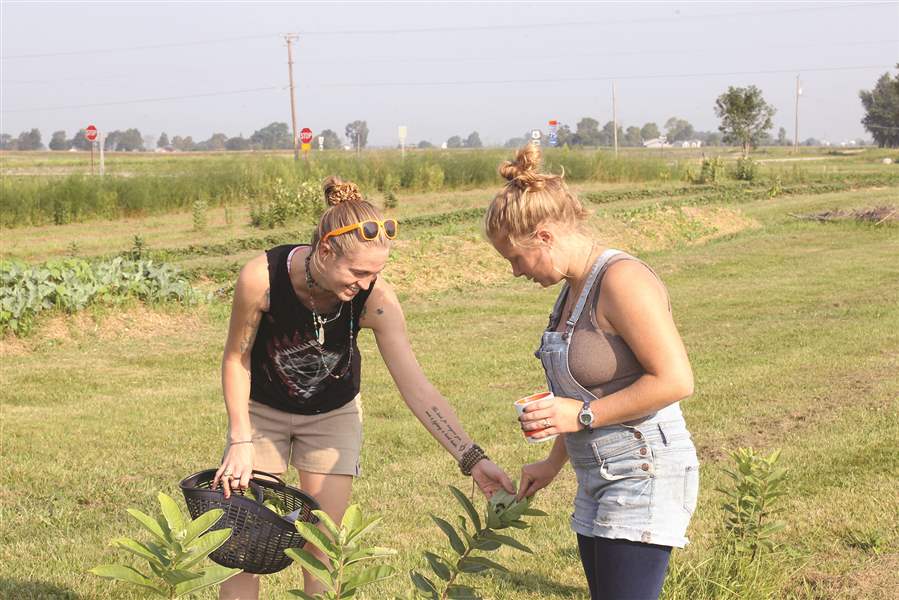
Emily Matthews, left, and Emma Norton observe a caterpillar while picking produce at Schooner Farm in Weston, Ohio.
The Blade/Shelby Kardell
Buy This Image
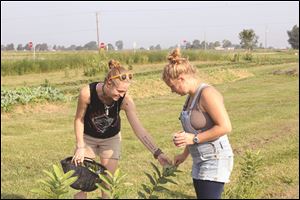
Emily Matthews, left, and Emma Norton observe a caterpillar while picking produce at Schooner Farm in Weston, Ohio.
Hugelkultur is happening along a Wood County road where it’s embraced so enthusiastically by one small-scale farmer that he’ll expound on its benefits at the drop of a sun hat.
“I can’t say enough about mounds,” says Don Schooner, owner of Schooner Farms.
He’s even built a one-third representation of Ohio’s Serpent Mound, planting sweet Mara Des Bois strawberries on its sloping sides and leeks on top.
Four years into using this ancient Eastern European method, Don Schooner believes “hoogle-culture” (its English pronunciation) is the ideal way to raise produce to its genetic potential.
Here’s what he’s found: plants grow faster, bigger, and have larger roots in the mound’s loose, microbe-rich soil. They taste better, are more nutritious, need minimal watering, and have an extended season.
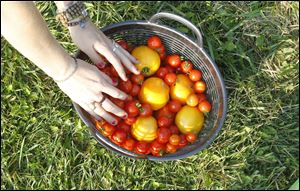
Emily Matthews picks tomatoes at Inspired by Nature, the Schooner Farm.
“You can plant a little sooner and harvest a little longer,” he says. Moreover, he figures production is one-and-half to two times better than in flat ground. And, there’s less bending down.
He calls Schooner Farms, at the juncture of U.S. 6 and State Rt. 235, a production farm that has U-pick strawberries, blackberries, and red raspberries (strawberries and blackberries are ripe now); a CSA garden (Community Supported Agriculture) in its sixth year of growing produce for 40 families, and an educational/event location with classrooms and an outdoor courtyard for gatherings.
Becky Schooner, his wife, is an herbalist who handles the farm’s marketing and social media.
In truth, these 20 acres of black sandy loam are both laboratory (the new tap-operated Flow bee hive, a planned seven-acre “food forest” with fruit and nut trees and perennial produce, and the possibility of fresh-water lobster) and playground (planned are a commercial kitchen in which to make food and herbal products, and construction of yurts for guests to stay in while learning about hugelkultur).
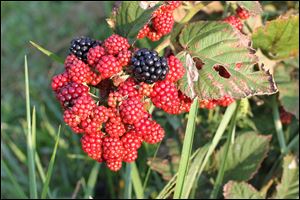
Blackberries wait to be picked at Inspired by Nature, the Schooner Farm, in Weston, Ohio.
And, of course, there will be more mounds. “Maybe in the shape of Celtic symbols or Morse code. I’m open.”
Full of ideas and boundless energy — he sleeps about four hours a night plus a catnap or two — Schooner, 47, has moved to Mother Nature’s rhythms since he was a child growing up a few miles from his farm. He’s hunted, been a deer tracker, collected and sold preying mantis cases by the tens of thousands, and worked in a garden center.
In 1989, he established a chapter of Wood/Lucas County Pheasants Forever of which he’s president. In 1996, he launched Inspired By Nature, an all-natural pond-management business. And in 2002, he dug three half-acre ponds, 19-feet at their deepest, in which blue tilapia feed on algae.
A new pay-to-fish operation will offer salmon and trout fishing in spring and fall, and in warmer weather, yellow perch, sunfish, bass, and bluegill. He’s also testing the feasibility of freshwater shrimp as well as aquaponic vegetables growing in fish water.
He’s a disciple of Aldo Leopold, the late wildlife-management visionary, and gives away copies of Leopold’s A Sand County Almanac by the case. He’s a land-ethic leader and a certified permaculture designer.
And there’s lots of lavender, which Mrs. Schooner uses to make essential oils. A labyrinth, outlined with 750 lavender plants, is a third of a mile in-and-out; it’s centered by an obelisk.
Smaller is better
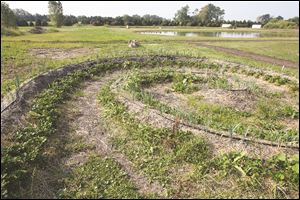
Don Schooner’s version of Ohio’s Serpent Mound.
Hugelkultur [a word of German origin] isn’t for the big-production grower, “but for the small farmer or gardener, this is beautiful,” Mr. Schooner says.
A dozen mounds are in production, ranging from 25- to 250-feet-long and about six-feet wide. They’re intensively planted with lettuce and broccoli, peppers and spinach, carrots and cabbages. Cukes and summer squash started from seed in early August are well on their way to providing a crop before frost. One 25-foot-long mound is packed with 250 sweet potato plants.
“We have 35 categories of vegetables and we have not found one that doesn’t like the mound,” he says. “We watch. We see. You’ve got to read the landscape. If you don’t read nature and you try to control it, good luck.”
A 250-foot-long strawberry bed on flat ground has 500 plants in black-plastic sheeting. When those plants are spent, he’ll put strawberries on mounds.
“If you were to build up a mound, you’d have 10-linear feet across the bed. I could put 2,500 strawberry plants on a 250-foot-long mound, so production would increase dramatically because we have more square feet of space.”
Most mounds are built north-to-south for maximum sun exposure, but near the ponds, he built several east-west mounds just to see how they’d do.
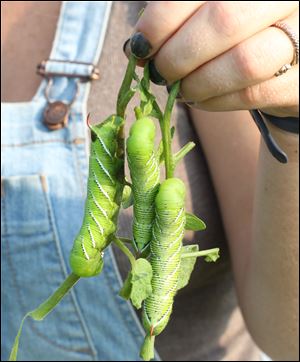
Emma Norton holds up tomato hornworms. Because the farm doesn't use pesticides, workers must pick them by hand.
One mound is left partially constructed so visitors can learn its anatomy. Its base is logs and stumps of select trees (he uses maple, cottonwood, oak, and ash). Next are piles of partially decomposed leaves, followed by fresh wood chips, then decomposed wood chips. On top of that, long branches serve as shoulder pads, providing shape near the top.
Then comes old straw or dried weeds (picked before they’ve gone to seed), three or four inches of finished compost (made on site or complements of a horse farm), and the same amount of topsoil.
“We pack it as tightly as we can but still it’s loose.” When done, it’s about 3-feet tall and 6-feet wide.
In its first year, a mound will shrink, requiring shoring up with compost and topsoil. Over time, it decreases to 24 to 30 inches but can be serviceable for 10 to 12 years before the wood has become rich topsoil.
The mound’s logs and branches hold water, making for a moist, spongy interior. And if there are parallel mounds, rainwater can be trapped between the two by damming the end of the paths with a board or pile of dirt. The wood “banks” the rainwater.
Schooner has watered the mounds six times this season via drip tape and has fertilized once or twice on the fall crops. “For the whole farm I haven’t used five gallons of organic fertilizer concentrate this year.”
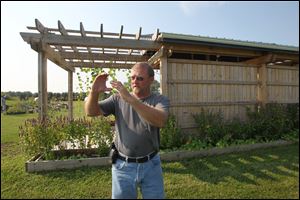
Don Schooner, owner of Schooner Farms, describes new Flow beehives. Mr. Schooner says ‘nature has natural patterns. And if you follow that pattern, you’ll be fine.’
A bonus: Mounds are flood and drought resistant.
“In the last two years we’ve had both. This year this whole area was under water and we lost nothing at all,” says Schooner, who took aerial photos of standing water with his drone camera. “The mounds absorbed the water and banked it.”
Next will be blueberries. “I’ll dig about 18-to 24-inches deep first, and fill with acidic pine needles and pine and spruce logs and branches.
“Not everything we do works. I want to be able to fail, to figure it out and learn.”
Schooner Farms is at 14890 Otsego Pike in Weston, schoonerberries.com, and 419-261-0908.
Contact Tahree Lane at: tlane@theblade.com or 419-724-6075.